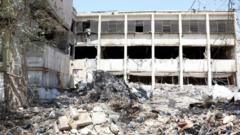In a complex geopolitical landscape, U.S. intelligence continues to monitor Iran's nuclear program, particularly focusing on the highly enriched uranium that remains shrouded in uncertainty following strategic military strikes.
**Unraveling the Enigma of Iran's Enriched Uranium Amid U.S. Strikes**

**Unraveling the Enigma of Iran's Enriched Uranium Amid U.S. Strikes**
In the wake of recent U.S. military actions, the status of Iran's enriched uranium stockpile turns into a pivotal point of concern for global security.
As recent U.S. and Israeli strikes against Iran’s nuclear facilities have raised questions regarding the future of the nation's 880-pound stockpile of enriched uranium, experts remain divided on whether Iran managed to relocate key materials ahead of the attacks. Vice President JD Vance emphasized the need for dialogue with Iran concerning this stockpile, yet the Trump administration voiced skepticism about whether the uranium was moved before the operation commenced. This ambiguity persists even as assessments confirm that Iran's nuclear capabilities were significantly weakened by the strikes. The intricate dynamics between assurance and confrontation continue to shape the region's security landscape.
---
After days of debate over how severely U.S. strikes had damaged three nuclear facilities in Iran, the fate of the country’s stockpile of enriched uranium remains a bigger mystery. Over the years, as Iran built up its underground nuclear facilities and centrifuges, it amassed a large, 880-pound stockpile of uranium enriched to 60 percent, near bomb grade. While U.S. intelligence agencies assessed that Iran had not decided whether to make a bomb, they noted that the nation was only a few steps away from being able to turn its uranium into a weapon given the size of that stockpile.
There is little doubt that Iran’s entire nuclear program was substantially diminished by U.S. and Israeli strikes, and that it would struggle to quickly produce additional nuclear fuel. However, U.S. intelligence had previously speculated that faced with military threats, Iran might attempt to relocate its enriched uranium—potentially as leverage in diplomatic negotiations or to hasten a nuclear armament race.
In an interview on Sunday, Vice President JD Vance indicated U.S. officials were keen to initiate discussions with Iran about the uranium stockpile. Yet by Thursday, the Trump administration expressed doubts about the possibility that Iran could have moved its enriched uranium prior to the U.S. strike, leaving the fate of this critical material still hanging in the balance amidst tumultuous tensions.
---
After days of debate over how severely U.S. strikes had damaged three nuclear facilities in Iran, the fate of the country’s stockpile of enriched uranium remains a bigger mystery. Over the years, as Iran built up its underground nuclear facilities and centrifuges, it amassed a large, 880-pound stockpile of uranium enriched to 60 percent, near bomb grade. While U.S. intelligence agencies assessed that Iran had not decided whether to make a bomb, they noted that the nation was only a few steps away from being able to turn its uranium into a weapon given the size of that stockpile.
There is little doubt that Iran’s entire nuclear program was substantially diminished by U.S. and Israeli strikes, and that it would struggle to quickly produce additional nuclear fuel. However, U.S. intelligence had previously speculated that faced with military threats, Iran might attempt to relocate its enriched uranium—potentially as leverage in diplomatic negotiations or to hasten a nuclear armament race.
In an interview on Sunday, Vice President JD Vance indicated U.S. officials were keen to initiate discussions with Iran about the uranium stockpile. Yet by Thursday, the Trump administration expressed doubts about the possibility that Iran could have moved its enriched uranium prior to the U.S. strike, leaving the fate of this critical material still hanging in the balance amidst tumultuous tensions.





















